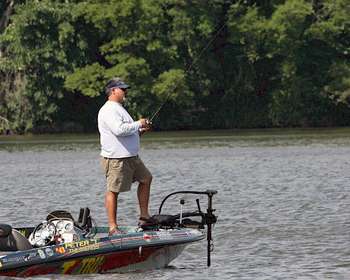
The annual transition from winter to spring brings with it the much-heralded arrival of every bass angler's delight — the spawn. However, for as much excitement as the spring spawn creates, prespawn can be equally compelling if you're looking for that fish of a lifetime.
Elite Series pro Peter Thliveros points out that many anglers seem to get a little too amped over the arrival of warm weather. As a result, they bypass the deeper transitional haunts of prespawn females in search of bedding activity in the shallows. "I'm considered to be an open water fisherman, which is okay with me because if I can find fish away from the bank I'm just tickled to death," admits Thliveros. "I'm just much more comfortable fishing that way, so for me, prespawn conditions are among my favorite."
During this time of year, egg-laden females will be in transition areas off the bank. "It can be a pretty volatile time to fish because the weather changes almost hourly during the early spring," he explains. "But those deeper prespawn fish are typically less affected by weather changes, making them a little more dependable once you've found where they're holding." He cautions that anglers must realize that when fishing prespawn bass in transition, "You're always going to be behind the fish." That is, during prespawn, bass that are holding in deeper transition areas are intent on heading to the bank, so targeting deeper water often means that you're intercepting bass as they attempt to move shallow.
For this reason, Thliveros explains that staying in deeper water can be a 'guts and glory' situation because if you miss the transition, you're suddenly fishing where the bass were and not where they are." Thliveros starts his search for prespawn bass in 10 to 15 feet of water. "How deep I start usually depends on water temperature," he allows. "From 48 to 55 degrees, I'll spend a little more time looking for those fish that are grouped up on secondary points leading into spawning areas." However, in the back of his mind is always the thought that those fish are going to be leaving as soon as the moon is right.
"I've seen times where those fish have literally left while I was fishing for them," he reveals. "Sometimes they'll be there for an hour in the morning, and then they're heading to the bank to spread out. Understanding that, and identifying a number of transition areas where you can stay in front of them, is a key to prespawn fishing." Conventional wisdom suggests that bigger females are among the last to arrive to the spawning festival; however, in his experience, conventional wisdom doesn't hold much water. "I've generally found that if the moon and water temperatures are right, they all move together," he says. "You can usually find bigger females grouped together during the prespawn transition. They'll be in a transitional area for just a little while before heading to the bank. It's just something that you've got to keep in your mind."
During the prespawn, Thliveros recommends identifying locations where the bass can be "cut off" before they head to the bank. "Secondary points that are leading to spawning coves are always the best bet," he explains. Thliveros offers this final piece of advice to anglers working deeper water for early spring bass, "Work in that 10- to 15-foot range and try to find a group of prespawn females, but keep in mind that if they're not there it's likely that you've already missed them so head to the bank and start working the shallows."




